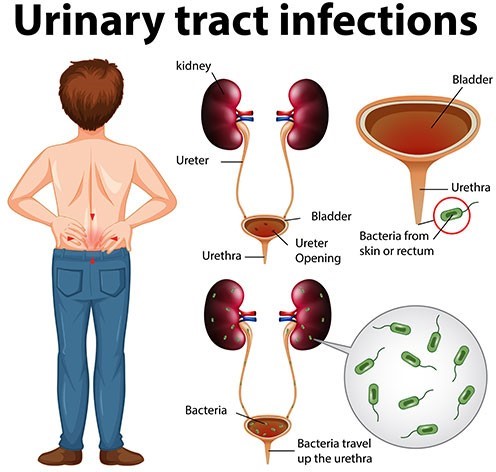A nurse is teaching a parent of a child who has a urinary tract infection. Which of the following should the nurse include in the teaching? (Select all that apply).
Avoid bubble baths.
Watch for manifestations of infection.
Empty the bladder completely with each void.
Wipe perineal area front to back.
Wear cotton underpants.
Correct Answer : A,B,C,D,E
The nurse should include all of these points in the teaching.
A. Avoiding bubble baths can help prevent irritation and infection.
B. Watching for manifestations of infection can help detect any worsening or recurrence of the infection.
C. Emptying the bladder completely with each void can help prevent urine from remaining in the bladder and causing infection.
D. Wiping the perineal area front to back can help prevent bacteria from
spreading to the urethra.
E. Wearing cotton underpants can help keep the area dry and reduce the risk of infection.

Nursing Test Bank
Naxlex Comprehensive Predictor Exams
Related Questions
Correct Answer is C
Explanation
Activated charcoal should be given as soon as possible to help absorb the acetylsalicylic acid in the gastrointestinal tract.
Choice A is not an answer because N-acetylcysteine is used to treat acetaminophen overdose, not acetylsalicylic acid overdose.
Choice B is not an answer because chelation therapy with deferoxamine is used to treat iron poisoning, not acetylsalicylic acid overdose.
Choice D is not an answer because inducing vomiting with syrup of ipecac is no longer recommended for the treatment of poisoning due to the potential for harm and lack of evidence of benefit.
Correct Answer is A
Explanation
The correct answer is Choice A.
Choice A rationale: The initial step in assessing unexplained bruising in a toddler is to gather information directly from the caregivers. This establishes a clinical baseline and allows the nurse to evaluate consistency, plausibility, and emotional responses. Bruising in toddlers can be developmental due to increased mobility, but patterns, location, and frequency matter. Normal platelet count ranges from 150,000 to 450,000/mm³; abnormal bruising may suggest thrombocytopenia, coagulopathy, or trauma. Early dialogue supports accurate documentation and escalation if needed.
Choice B rationale: While engaging the toddler may seem appropriate, their developmental stage limits reliable verbal communication. Toddlers typically lack the cognitive and linguistic capacity to describe events accurately, especially those involving trauma or abuse. Their responses may be influenced by fear, confusion, or limited vocabulary. Relying on their account prematurely risks misinterpretation and emotional distress. Assessment should prioritize adult sources first, followed by observational and clinical data to guide further action.
Choice C rationale: Notifying social services is a critical step in suspected abuse but must follow preliminary assessment and documentation. Premature reporting without context may lead to unnecessary distress for the family and compromise the integrity of the investigation. The nurse must first gather objective findings, caregiver explanations, and clinical indicators. Social services involvement is warranted when findings suggest non-accidental trauma, inconsistent histories, or high-risk environments. The decision must be evidence-informed and procedurally sound.
Choice D rationale: Notifying the provider is essential for collaborative care but should follow initial data collection. The provider relies on the nurse’s observations and caregiver input to determine next steps, including diagnostic testing or referral. Immediate escalation without context may delay appropriate triage or misdirect resources. The nurse’s role includes thorough documentation, pattern recognition, and initiating dialogue with caregivers to inform the provider’s clinical judgment. This ensures a coordinated, evidence-based response.
Whether you are a student looking to ace your exams or a practicing nurse seeking to enhance your expertise , our nursing education contents will empower you with the confidence and competence to make a difference in the lives of patients and become a respected leader in the healthcare field.
Visit Naxlex, invest in your future and unlock endless possibilities with our unparalleled nursing education contents today
Report Wrong Answer on the Current Question
Do you disagree with the answer? If yes, what is your expected answer? Explain.
Kindly be descriptive with the issue you are facing.
